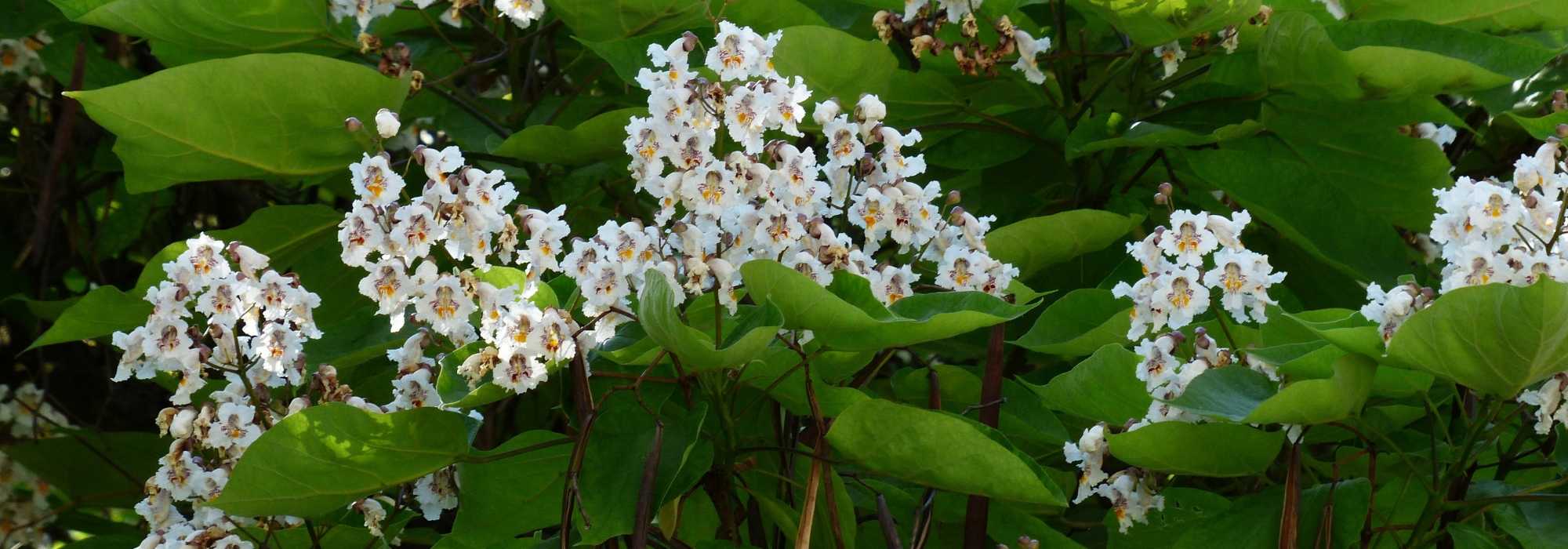
Catalpa: planting, pruning and care
Contents
Catalpa, in a nutshell
- Catalpa is a medium to small tree with a wide crown and large heart-shaped leaves, identifiable by its green to black bean-shaped fruits.
- Fast-growing, it provides thick and beneficial shade in summer, complemented by a spectacular flowering in upright clusters.
- Apart from the well-defined Catalpa boule, lesser-known cultivars display foliage coloured in lemon yellow (Catalpa bignonoides ‘Aurea’), purple (Catalpa erubescens ‘Purpurea’), or cream-speckled (Catalpa speciosa ‘Pulverulenta’).
- Very easy to grow, the bean tree thrives in full sun, in any fresh and well-drained soil under most of our climates.
A word from our expert
Catalpa is a very beautiful shade tree appreciated for its summer white flowering in large upright clusters and its imposing deciduous foliage in the shape of a heart. It bears original bean-shaped fruits, hence its other name of bean tree or cigar tree.
Catalpa bignonioides is most often planted in our gardens, but one can sometimes be surprised by the dimensions it reaches, ranging between 10 and 20 m in height and 10 m in diameter! Fortunately, it tolerates being cut back to the ground, producing strong shoots of 3-4 m in a year that generate leaves over 30 cm long. This very clever technique allows, as with Paulownia, to give an exotic touch in a small garden with a very hardy plant that simply needs to be treated like a perennial with annual pruning!
Ball Catalpa (Catalpa bignonioides Nana) forms a small tree just as common as the typical species, useful for structuring small gardens with its very compact umbrella habit of 3 m in diameter and up to 5 m in height. It can highlight a path, serve as a focal point, or mark an intersection… It is worth noting that it does not flower, but it has many other qualities: it requires no pruning, 9 square metres of air space at 3-5 m in height is sufficient, with a welcome cluster of bushes at its base, and it is really not demanding! Its cousin, Catalpa bungei, is often confused with it, as it also has a ball shape but reaches 8 m in height and 4 m in width. It flowers in white clusters striped with purple, fruits, and its leaves are coarsely dentate.
Some very beautiful species that are still little known broaden the range of Catalpas, such as the hybrid x erubescens Purpurea which delivers spring foliage tinged with purple, evolving to dark green, with large lobed laminae with points rather than heart-shaped. The golden form ‘Aurea’ of the species bignonioides, which has a short trunk and lesser vigour, fits perfectly into an English-style border, flanked for example by Miscanthus with purple spikes, hydrangeas, or landscape roses. Its lemon yellow hue persists for a good part of the summer before turning green.
Description and Botany
Botanical data
- Latin name Catalpa sp.
- Family Bignoniaceae
- Common name Bean tree, cigar tree
- Flowering between June and August
- Height between 5 and 30 m
- Exposure sun or partial shade
- Soil type any well-drained moist soil
- Hardiness Excellent (-30°C)
Catalpas are fast-growing trees native to North America and East Asia. The genus includes 11 species, planted for ornamentation or for the quality of the wood, belonging to the Bignoniaceae family. The most commonly planted species along our avenues and parks is Catalpa bignonioides. It is native to the warm regions of the southeastern United States from western Florida to Mississippi and prefers the humid environments of riverbanks or swamps. It is tolerant of pollution and enjoys warm sheltered situations and fertile soils.
This fast-growing tree easily reaches 8 m after 20 years, growing up to 15 m tall in cultivation. It develops a rather loose and irregular crown with large heart-shaped leaves. Bud burst is quite late in May and leaf drop is early.
The trees exhibit deciduous foliage that is opposite or whorled in threes, of considerable size, reaching 10 to 25 cm long, identifiable by the unpleasant smell it emits when crushed. The foliage is of a rather light green, creating a cool shaded atmosphere that remains bright. The underside of the lamina is downy while the upper side is glabrous, unlike the leaves of Paulownia which are downy on both sides.

Catalpa bignonoides – botanical illustration
It ends with a fine point or three points as seen in Catalpa x erubescens. The latter results from the cross-breeding between the common Catalpa and a Chinese species, Catalpa ovata, with trilobed leaves. The cultivar with lemon-yellow foliage, C. bignonioides ‘Aurea’, is less vigorous, reaching 8 to 10 m tall and 5 to 8 m wide, and blends successfully into a bed of shrubs with colourful foliage, maintaining a bright light green hue throughout summer. The foliage darkens before falling quite early.
The flowering of catalpas appears in the form of upright pyramid-shaped panicles 15 to 25 cm tall, featuring campanulate flowers 2.5 to 6 cm wide. The corolla forms an open trumpet-shaped white tube with serrated edges, having a throat speckled with purple and maculate with yellow in the common Catalpa, pure white and violet in the Cordate or elegant Catalpa (Catalpa speciosa). This latter species, native to the central Mississippi basin, capable of reaching 36 m in height, is cultivated for its wood and sometimes for ornamentation in Europe. It is distinguished by a conical habit, an earlier flowering in June-July, less spectacular than in bignonioides but with larger (6 cm) and fewer flowers. Its pendulous fruits measure 20 to 50 cm long and contain seeds of 2.5 cm. Its cultivar ‘Pulverulenta’ hardly exceeds 5 m in height and has original white-speckled foliage that brightens dark areas.
The fruits of the catalpa catch the attention of passers-by as the resemblance to beans is striking. The Cherokee name catalpa has come down to us, meaning “Indian bean.” It is a siliqua, a type of cylindrical pod with a central membrane like that of the Brassicaceae (cabbages), which differentiates it from a true pod. The brown beans of the catalpa, with their fine and elongated shape of 15 to 40 cm, create a sort of dense root hairs, quite strange on the bare silhouette of the tree in winter.

Catalpa bignonioides: foliage (photo Maja Dumat), flowers, tree in situ (photo Gilles Douaire) and fruits
Read also
Albizia: planting, pruning and careThe main varieties of Catalpa
Our Favourite Varieties
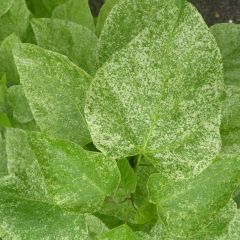
Catalpa speciosa pulverulenta
- Flowering time July, August
- Height at maturity 5 m
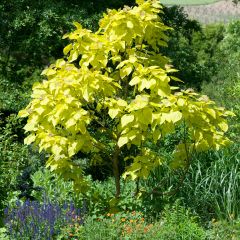
Catalpa bignonioides Aurea
- Flowering time June, July
- Height at maturity 7 m
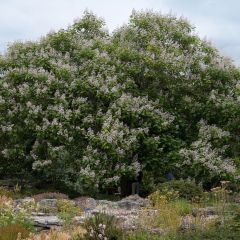
Catalpa erubescens Purpurea
- Flowering time August, September
- Height at maturity 10 m
Discover other Catalpa
View all →Available in 1 sizes
Available in 2 sizes
Available in 3 sizes
Available in 1 sizes
Available in 1 sizes
Available in 1 sizes
Available in 2 sizes
Planting
Where to plant the Catalpa?
Catalpas prefer deep, cool, fertile soils but are quite accommodating, tolerating temporarily moist or porous (non-compacted) and polluted soils, such as in urban conditions. Opt for well-drained soils to avoid root rot (armillaria). They thrive in full sun provided they are in a sheltered position away from strong, drying winds and salt spray but tolerate light shade. The light, golden, or variegated cream foliage, as well as the purple, can accept a semi-shaded position.
They are not very drought-tolerant but offer excellent hardiness, allowing them to withstand frosts down to -30°C.
Catalpa speciosa develops a running root system. Place it far enough from buildings to avoid damaging your foundations. It tolerates hydromorphic and dry soils, unlike the bignonioides species, and requires full sun for the typical species.
When to plant?
Plant Catalpas during autumn-winter to ensure deep rooting before facing summer drought.
How to plant?
Avoid planting young plants with bare roots; instead, choose container-grown specimens.
- Soak the root ball in a bucket of water to thoroughly moisten it.
- Dig a planting hole 80 cm wide and 60 cm deep.
- Add a 10 cm drainage layer (gravel, sand…) if your soil is clayey.
- Add manure or decomposed compost if the soil is sandy.
- Place the plant in the planting hole.
- Replace the soil and lightly firm it down.
- Water and create a good basin to ensure effective watering. Spread a layer of mulch around the base to maintain good moisture around the roots. This will also limit the growth of weeds.
Recovery is easy and quick, requiring only monitoring of watering during the first two years after planting.
You can also plant a Catalpa in a pot! Follow our advice in: Planting and growing a Catalpa in a pot.
 Catalpa in full fruiting, also known as the bean tree</caption]
Catalpa in full fruiting, also known as the bean tree</caption]
Pruning and care
In the beautiful season, water supplies should be regular, especially during the first 2-3 years of planting.
Catalpa does not really require pruning. The catalpa tree can be pruned to give a more regular shape to the crown.
For other catalpas, simply remove dead or damaged wood, crossing branches, and low branches that obstruct passage. Operate at the end of winter.
→ Learn more in our tutorial: How to prune a Catalpa?
Easy to grow and resistant to diseases, this tree generally poses no health problems if it benefits from good conditions and receives enough water.
Young newly planted trees sometimes suffer from powdery mildew (white fluff on the leaves). Water generously at the base in case of prolonged drought and treat with sulphur when the temperature does not exceed 25°C (risk of toxicity!). An attack of aphids or scale insects does not require treatment on an adult specimen. Apply a treatment with black soap and brush the trunk (for scale insects) of young specimens.
The drying out of certain branches can be caused by verticillium wilt, a fungus that remains in the soil for a long time. Cut off the affected branches and avoid replanting a catalpa in that spot if it were to die.
→ Learn more about diseases and pests of Catalpa in our advice sheet!
Propagation: sowing, propagation by cuttings
Catalpa can be sown in autumn or propagated by cuttings in late spring to summer. Grafting by shield is done in late summer or winter.
Sowing
- Harvest seeds from typical species of catalpa after opening the well-brown pods.
- Sow them in autumn in a seed tray filled with equal parts of sand and potting soil.
- Place the culture under a cold frame while keeping the substrate moist.
Propagation by cuttings
Carry out the operation in autumn on well-lignified wood.
- Prepare a deep pot by filling it with potting soil mixed with sand.
- Take a lignified shoot of 15-20 cm with a heel.
- Insert the cuttings two-thirds of their height, ensuring they do not touch each other.
- Gently firm the soil around to eliminate air pockets and ensure good contact between the potting soil and the cutting.
- Place under a cold frame to protect from heavy rain.
- Separate the rooted cuttings in spring to plant them in individual pots and wait until the following autumn to place them in their final position.
→ Learn more about catalpa multiplication methods in our tutorial.
Uses and associations
The common catalpa is an imposing tree that requires space to showcase its irregularly shaped spreading crown, which sometimes extends down to the ground. It thrives in large gardens as well as along avenues, in a semi-free form (with a raised canopy), as it is not afraid of urban pollution.

An example of pairing in a country garden: hardy geraniums including ‘Patricia’, Digitalis purpurea, Crambe cordifolia, roses including Rosa versicolor and Alchemilla mollis whose colour complements that of Catalpa bignonioides ‘Aurea’ in the background
Plan for a ground width of 8 to 10 m unless you regularly prune the tree or train it into a “cat head” shape through repeated cuts in the same place. You can also train it on a short trunk at 50 cm from the ground, cutting the leading shoot when the trunk diameter does not exceed 3 cm.
You can pair the golden, purple, or cream-speckled leaf forms with flowering shrubs and colourful foliage that will extend the appeal of the bed in autumn when the catalpa has lost its leaves. We suggest flanking the Aurea catalpa with a Miscanthus sinensis ‘Ghana’ with purple-pink spikes and foliage, and extending the bed on either side with various hydrangeas such as serrata, macrophylla, paniculata, etc., or landscape roses. The lemon-yellow hue of the catalpa persists for a good part of the summer before turning to a very bright light green.
→ Discover more beautiful pairings with the catalpa
To go further
Discover our wide range of Catalpas.
Discover beautiful associations with Catalpa.
Our advice sheet: Shade tree: adopt Catalpa for a cool and elegant garden.
Frequently asked questions
-
Can you prune to reduce the size of a catalpa?
The wood of the catalpa does not tolerate heavy pruning well and can easily start to rot if healing does not occur. On the other hand, it reacts quite vigorously to a heavy cut by producing long and numerous shoots, which increases the risk of branch breakage if action is not taken to lighten the weight of the crown. A coppice management system, cut back every 3 to 5 years, can be considered to maintain a bushy shape for your catalpa, or a pollarded tree management system, which has a somewhat old-fashioned character.
- Subscribe!
- Contents
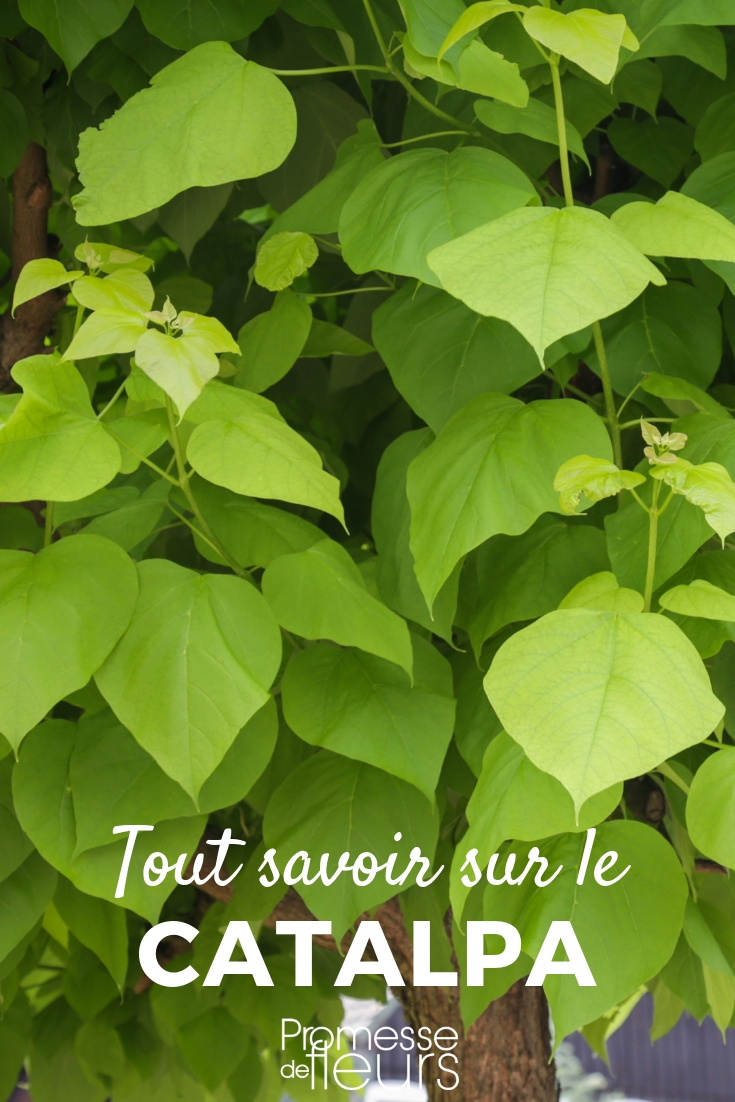


































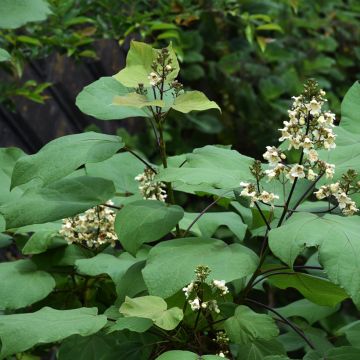
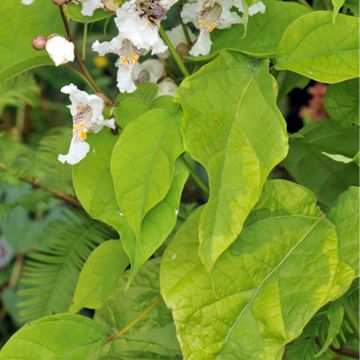

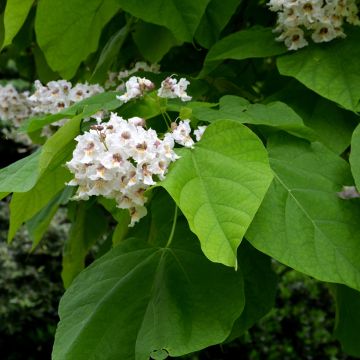
Comments